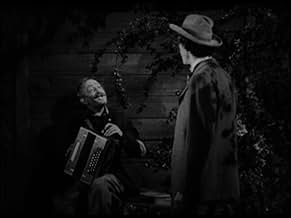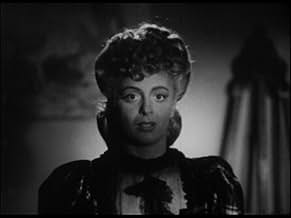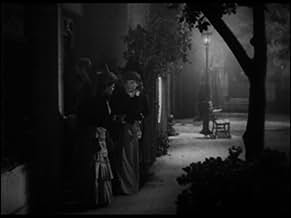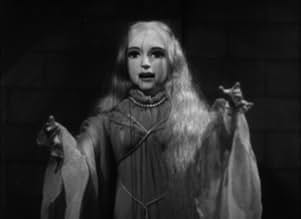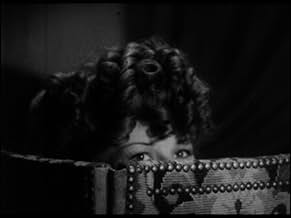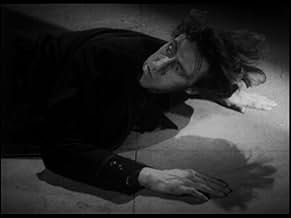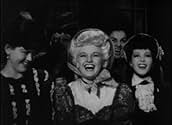CALIFICACIÓN DE IMDb
5.9/10
2.3 k
TU CALIFICACIÓN
Agrega una trama en tu idiomaIn Paris, an artist hires portrait models, and after he finishes their portraits, he strangles them.In Paris, an artist hires portrait models, and after he finishes their portraits, he strangles them.In Paris, an artist hires portrait models, and after he finishes their portraits, he strangles them.
- Dirección
- Guionistas
- Elenco
Ludwig Stössel
- Jean Lamarte
- (as Ludwig Stossel)
Harry Cording
- Policeman
- (sin créditos)
Frank Darien
- Inquiry Judge
- (sin créditos)
Bess Flowers
- Courtroom Spectator
- (sin créditos)
Mabel Forrest
- Woman
- (sin confirmar)
- (sin créditos)
Eddie Hall
- Paul
- (sin créditos)
- Dirección
- Guionistas
- Todo el elenco y el equipo
- Producción, taquilla y más en IMDbPro
Opiniones destacadas
This telling of French serial killer Bluebeard (why was he called Bluebeard?) is notable for two reasons - one is John Carradine's haunting yet believable portrayal of a madman's psyche, and the other is for Edgar G. Ulmer's ability to create mood and even grandeur on a tiny budget. While Carradine's acting skills have never been in question, his over-the-top scene stealing in many small roles would make one approach him with caution in a leading role. However, Carradine manages to restrain himself enough to never grow old or cumbersome in the role, while simultaneously delivering his lines memorably - leading to the excellent final crescendo. The plot never tires, the direction is masterful, the ensemble acting (especially the devious art dealer Lamarte) far better than expected, and the final feeling one of satisfaction. While all of this is unadulterated praise, the movie does appear a tad bit stagey (via budgetary concerns) at times, and also moves slowly at certain points. Despite this, Bluebeard is not merely an excellent time-waster, but a movie worthy of any viewer going out, renting, and popping in.
Bluebeard is probably most notable for the fact that its lead star, John Carradine, famously named his role here as his favourite across his lengthy list of film credits. It's easy to see why the man himself enjoyed playing this part so much too - Carradine's role in Bluebeard allows him to act at his most sinister, and the film really depends on him as this is very much a one-man story. Carradine has just the right look for this sort of role also, and all these elements combine nicely to ensure that Carradine's part in this film is a success. The base for the plot is one of cinema's most common and most prolific, but this film is notable for being one of the earlier films to use it. We follow a deranged madman who likes to paint girl's pictures before he strangles them to death. The man himself is famous for two completely different lives; in one, he is the notorious serial killer 'Bluebeard', who prays on beautiful young women - and in the other he's Gaston Morrell, a dapper up and coming young painter. This film's major problem is certainly not with the plot, stars, or style; it's with the plotting.
Bluebeard falls down primarily because it moves at snail pace. The plot is intriguing, but the way it presents itself is the opposite, and it's a shame because, if handled with care, this film could have been really good instead of just being good. Director Edgar G. Ulmer is most famous for his directing credit on classic film 'The Black Cat', and is lesser known for his set design on films such as Fritz Lang's Die Nibelungen, M and Metropolis; as well as silent classics; Sunrise and Der Golem. Ulmer's previous experience helps him with Bluebeard, as the film is constantly atmospheric, and the director makes best use of his simple sets by way of his use of the camera and the murky black and white cinematography. The film is very bleak throughout, and this massively helps the plot as it gives the film just the right amount of foreboding. Plots like this have been turned into better films since the release of this film over sixty years ago; but Bluebeard is still well worth seeing. The film starts out slow, but it does pick up and not even an extremely overlong puppet sequence can fully degenerate the film into the realms of absolute boredom. It's not must see; but worth seeing if the chance presents itself.
Bluebeard falls down primarily because it moves at snail pace. The plot is intriguing, but the way it presents itself is the opposite, and it's a shame because, if handled with care, this film could have been really good instead of just being good. Director Edgar G. Ulmer is most famous for his directing credit on classic film 'The Black Cat', and is lesser known for his set design on films such as Fritz Lang's Die Nibelungen, M and Metropolis; as well as silent classics; Sunrise and Der Golem. Ulmer's previous experience helps him with Bluebeard, as the film is constantly atmospheric, and the director makes best use of his simple sets by way of his use of the camera and the murky black and white cinematography. The film is very bleak throughout, and this massively helps the plot as it gives the film just the right amount of foreboding. Plots like this have been turned into better films since the release of this film over sixty years ago; but Bluebeard is still well worth seeing. The film starts out slow, but it does pick up and not even an extremely overlong puppet sequence can fully degenerate the film into the realms of absolute boredom. It's not must see; but worth seeing if the chance presents itself.
A PRC poverty row production that makes the most of its limited budget. A lot of credit should go to production designers Eugene Shufftan and Edgar Ulmer who collaborated on the movie's sumptuous look. Even when the middle part drags, the visuals remain arresting. Note too how the meagre exterior sets are stylized to make up for the limitations. Of course, cult director Ulmer was no stranger to transforming army surplus material into artistic effects. The overall result is an atmospheric recreation of 19th century Paris.
Making Carradine's Bluebeard a puppeteer is a novel and interesting wrinkle. Then too, I can't help thinking there is more plot potential in continuing with Bluebeard the puppet master than in shifting the story line over to Bluebeard the painter, as the screenplay does. Nonetheless, those early scenes in the park are good ones. However, the cadaverous actor who can be as florid and intense as anyone seems a little too understated here. While physically he looks the part of the grim reaper, Carradine is simply no good as a simpering lover, while too many of his scenes lack the menace the role calls for. Unfortunately, the result compares unfavorably, for example, with Laird Cregar's riveting Jack the Ripper in that Gothic thriller The Lodger of the same year. It appears Ulmer is much more the visual artist than the thespic coach.
Nonetheless, the movie remains an interesting curiosity. Consider the sheer wackiness of presenting Iris Adrian whose cheap Brooklyn accent can barely be disguised as a Parisian. Still, it does amount to an amusing turn. Also, note the off-angle camera staging of Carradine's flashback sequence, which is both effective in identifying the sequence and artfully composed. Such camera effects were hardly a Hollywood staple at a time when producers generally felt they would confuse the audience.
Of course, there's the question that always arises for fans of Ulmer. What would he have done with an A-budget and A-material in a career spent in the lower depths of Hollywood production. Hard to say-- perhaps he needed the challenge of PRC-type constraints. However, I think it's fair to say that none of his poverty row productions are without genuine points of interest and entertainment, and-- as is the case with Bluebeard-- may even rise at times to artistic levels.
Making Carradine's Bluebeard a puppeteer is a novel and interesting wrinkle. Then too, I can't help thinking there is more plot potential in continuing with Bluebeard the puppet master than in shifting the story line over to Bluebeard the painter, as the screenplay does. Nonetheless, those early scenes in the park are good ones. However, the cadaverous actor who can be as florid and intense as anyone seems a little too understated here. While physically he looks the part of the grim reaper, Carradine is simply no good as a simpering lover, while too many of his scenes lack the menace the role calls for. Unfortunately, the result compares unfavorably, for example, with Laird Cregar's riveting Jack the Ripper in that Gothic thriller The Lodger of the same year. It appears Ulmer is much more the visual artist than the thespic coach.
Nonetheless, the movie remains an interesting curiosity. Consider the sheer wackiness of presenting Iris Adrian whose cheap Brooklyn accent can barely be disguised as a Parisian. Still, it does amount to an amusing turn. Also, note the off-angle camera staging of Carradine's flashback sequence, which is both effective in identifying the sequence and artfully composed. Such camera effects were hardly a Hollywood staple at a time when producers generally felt they would confuse the audience.
Of course, there's the question that always arises for fans of Ulmer. What would he have done with an A-budget and A-material in a career spent in the lower depths of Hollywood production. Hard to say-- perhaps he needed the challenge of PRC-type constraints. However, I think it's fair to say that none of his poverty row productions are without genuine points of interest and entertainment, and-- as is the case with Bluebeard-- may even rise at times to artistic levels.
Paris ,France , a tormented painter and puppeteer called Gaston Morrell (one of John Carradine's best vehicles) has a psychopatic urge to strangle gorgeous women . As he contacts Parisian women through his paintings posing as models he seduces and eventually kills them in order to carry out his dark purports . Among those getting the ending curtain call from "bluebeard" (is a type of serial killer ; specifically, it is a man who murders his wives or lovers , this type is named after the fictional "Bluebeard") are Francine Lutien , Lucille Lutien and Renee Claremont .
This chiller is based on lady killer Henry-Denise Landru who seduced and murdered several women . The flick realized Noir style packs thrills , chills , drama , suspense and a lot of murders . Good acting by John Carradine as an artist hires portrait models, and after he finishes their portraits, he strangles them . It features John Carradine's own favorite performance . Furthermore , there appears Jean Parker as Lucille Lutien and Nils Asther and Inspector Jacques . And film debut of actress Sonia Sorel -Mrs. John Carradine- , who went on to do several more titles for director Edgar G. Ulmer.
The failure of the original copyright holder to renew the film's copyright resulted in it falling into public domain, meaning that virtually anyone could duplicate and sell a VHS/DVD copy of the film. Therefore, many of the versions of this film available on the market are either severely and usually badly edited and/or of extremely poor quality, having been duplicated from second- or third-generation or more copies of the film . Eugen Schüfftan was actually the director of photography but could not be credited on screen because he was not yet a member of the cinematographer's union . So he was credited as production designer, the job actually done by director Edgar G. Ulmer, while the camera operator Jockey Arthur Feindel was credited as director of photography . This Noir film was professionally directed by Edgar G Ulmer , being filmed in six days . Edgar was born on September 17, 1904 in Olmütz, Moravia, Czech Republic as Edgar George Ulmer. He was a director and writer, known for Satanás (1934), Detour (1945) and People on Sunday (1930) , Aníbal (1959) , The Amazing Transparent Man (1960) , Beyond the Time Barrier (1960) , among others .
Other films dealing with this known character , Henry ¨Bluebeard¨ Landru , -who was really father of various children, disposed and married 11 wives and killed them in order to feed his little family , being subsequently beheaded- , are the followings : ¨Bluebeard¨ (1901) by George Melies ; ¨Monsieur Verdoux¨ (1947) with Charles Chaplin and Martha Ryer ; ¨Bluebeard's 10 honeymoon¨ by W.L. Wilder with George Sanders , Patricia Roc and Corinne Calvet ; ¨Bluebeard¨(1963) by Claude Chabrol with Charles Denner , Stephane Audran , Danielle Darrieux , Michele Morgan and Hildegarde Neff ; soporific remake titled ¨Bluebeard¨(1972) by Edward Dmytryck with Richard Burton, Joey Heatherton , Rachel Welch , Sybil Danning , Natahalie Delon , Virna Lisi ; and ¨¨Bluebeard¨(2009) by Catherine Breillat with Dominique Thomas and Lola Creton .
This chiller is based on lady killer Henry-Denise Landru who seduced and murdered several women . The flick realized Noir style packs thrills , chills , drama , suspense and a lot of murders . Good acting by John Carradine as an artist hires portrait models, and after he finishes their portraits, he strangles them . It features John Carradine's own favorite performance . Furthermore , there appears Jean Parker as Lucille Lutien and Nils Asther and Inspector Jacques . And film debut of actress Sonia Sorel -Mrs. John Carradine- , who went on to do several more titles for director Edgar G. Ulmer.
The failure of the original copyright holder to renew the film's copyright resulted in it falling into public domain, meaning that virtually anyone could duplicate and sell a VHS/DVD copy of the film. Therefore, many of the versions of this film available on the market are either severely and usually badly edited and/or of extremely poor quality, having been duplicated from second- or third-generation or more copies of the film . Eugen Schüfftan was actually the director of photography but could not be credited on screen because he was not yet a member of the cinematographer's union . So he was credited as production designer, the job actually done by director Edgar G. Ulmer, while the camera operator Jockey Arthur Feindel was credited as director of photography . This Noir film was professionally directed by Edgar G Ulmer , being filmed in six days . Edgar was born on September 17, 1904 in Olmütz, Moravia, Czech Republic as Edgar George Ulmer. He was a director and writer, known for Satanás (1934), Detour (1945) and People on Sunday (1930) , Aníbal (1959) , The Amazing Transparent Man (1960) , Beyond the Time Barrier (1960) , among others .
Other films dealing with this known character , Henry ¨Bluebeard¨ Landru , -who was really father of various children, disposed and married 11 wives and killed them in order to feed his little family , being subsequently beheaded- , are the followings : ¨Bluebeard¨ (1901) by George Melies ; ¨Monsieur Verdoux¨ (1947) with Charles Chaplin and Martha Ryer ; ¨Bluebeard's 10 honeymoon¨ by W.L. Wilder with George Sanders , Patricia Roc and Corinne Calvet ; ¨Bluebeard¨(1963) by Claude Chabrol with Charles Denner , Stephane Audran , Danielle Darrieux , Michele Morgan and Hildegarde Neff ; soporific remake titled ¨Bluebeard¨(1972) by Edward Dmytryck with Richard Burton, Joey Heatherton , Rachel Welch , Sybil Danning , Natahalie Delon , Virna Lisi ; and ¨¨Bluebeard¨(2009) by Catherine Breillat with Dominique Thomas and Lola Creton .
John Carradine plays Blubeard--he paints women and then strangles them to death. He doesn't want to do it but is compelled to (we find out why at the end). Then he falls in love with beautiful Lucille (Jean Parker) and tries to fight his desire...
John Carradine said this was his best performance--he's right! He's dead on target in the title role. He shows that Bluebeard is not evil and driven by impulses beyond his control. He uses body language and facial expressions perfectly. Also director Edgar G. Ulmer directs this beautifully with strange camera angles and lots of shadows making this very atmospheric. Also there are some beautifully done background paintings.
But this was done over at PRC--a poverty row studio. Unfortunately it shows. The furnishings and costumes look pretty tacky and it just FEELS low budget. Also the biggest problem is constant background music. It's ALWAYS playing and very annoying. Half the time the music doesn't even match the mood of what's being acted! These prevent the film from becoming a true classic.
As it stands I'm giving it an 8 for Carradine and Ulmer. It should be seen just for them. Also this is one of the few films that prove what a good actor Carradine actually was.
John Carradine said this was his best performance--he's right! He's dead on target in the title role. He shows that Bluebeard is not evil and driven by impulses beyond his control. He uses body language and facial expressions perfectly. Also director Edgar G. Ulmer directs this beautifully with strange camera angles and lots of shadows making this very atmospheric. Also there are some beautifully done background paintings.
But this was done over at PRC--a poverty row studio. Unfortunately it shows. The furnishings and costumes look pretty tacky and it just FEELS low budget. Also the biggest problem is constant background music. It's ALWAYS playing and very annoying. Half the time the music doesn't even match the mood of what's being acted! These prevent the film from becoming a true classic.
As it stands I'm giving it an 8 for Carradine and Ulmer. It should be seen just for them. Also this is one of the few films that prove what a good actor Carradine actually was.
¿Sabías que…?
- TriviaFeatures John Carradine's own favorite performance.
- ErroresWhen the artist is going to paint the model "unobserved", it's done so by arranging mirrors so he can see her but she supposedly can't see him. In reality, however, no matter how many mirrors you use or how you arrange them, if you can see another person in the reflection(s), they can see you.
- Citas
Gaston Morrell: Lucille, I want to tell you something no other living person knows...
- ConexionesFeatured in Creature Features: The Mummy (1971)
- Bandas sonorasFaust
(1859) (uncredited)
Written by Charles Gounod
Excerpts played and sung in English at the marionette show
Excerpts played often in the score
Selecciones populares
Inicia sesión para calificar y agrega a la lista de videos para obtener recomendaciones personalizadas
- How long is Bluebeard?Con tecnología de Alexa
Detalles
- Tiempo de ejecución1 hora 12 minutos
- Color
- Relación de aspecto
- 1.37 : 1
Contribuir a esta página
Sugiere una edición o agrega el contenido que falta

Principales brechas de datos
By what name was Barba Azul (1944) officially released in India in English?
Responda
